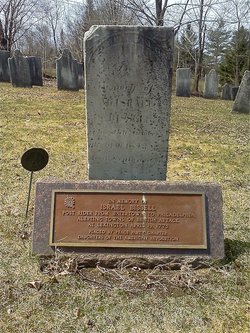“The Bearer, Israel Bissell, is charged to alarm the country quite to Connecticut and all persons are desired to furnish him with fresh horses as they may be needed.”
~General Joseph Palmer
Henry Wadsworth Longfellow’s most famous poem, “Paul Revere’s Ride,” appeared in a Boston newspaper on December 18, 1860. Two days later, South Carolina seceded from the United States government. Many historians have argued that Longfellow was trying to engender a sense of patriotism in the wake of the tumultuous and chaotic Democratic National Convention of 1860. The conventions were held in Charleston and Baltimore, where it became evident that the country’s core political systems were failing. Longfellow recognized that the government “by-the-people” was in trouble and “Paul Revere’s Ride” was penned to remind Americans of the struggles of the founding fathers. With the poem, he created a two hundred thirty-nine year long trail of misinformation, and omitted Israel Bissell, a patriot and post rider who rode three hundred and forty five miles from Boston to Philadelphia spreading the word that the American Revolution had begun.
Longfellow asserts that Revere’s mission was to warn the townsfolk of the approaching British Army. In reality, Paul Revere’s only mission was to ride the twenty miles from Boston to Lexington to warn John Adams and John Hancock. He achieved his mission, and was captured by British soldiers and interrogated by officers for several hours until the first battle of the Revolution erupted on Lexington Green. It was left to the forty or so other riders, including Bissell, to deliver the message of the impending British attacks on the American colonies.
 Although Longfellow and the history books forgot Israel Bissell, much is known about the twenty three year old post rider’s gallant five and a half day’s ride to Philadelphia. On April 19, 1775, Bissell, a regular postal rider, was handed a note by General Joseph Palmer of the Massachusetts militia. The note read, “‘To all friends of American liberty, be it known that this morning before the break of day, a brigade consisting of about 1,000 or 1,200 men...marched to Lexington, where they found a company of our colony militia in arms, upon whom they fired, without any provocation, and killed 6 men and wounded 4 others. By an express from Boston, we find that another brigade are now upon their march from Boston, supposed to be about 1,000.’” This message, which announced the beginning of the American Revolution, was to travel in secret with the regular mail service to assure that the rider, Bissell, would not be detained by British soldiers along his route. Legend has that within two hours of departing Watertown, Mass., eight miles from Boston, Bissell had ridden his horse to death.
Although Longfellow and the history books forgot Israel Bissell, much is known about the twenty three year old post rider’s gallant five and a half day’s ride to Philadelphia. On April 19, 1775, Bissell, a regular postal rider, was handed a note by General Joseph Palmer of the Massachusetts militia. The note read, “‘To all friends of American liberty, be it known that this morning before the break of day, a brigade consisting of about 1,000 or 1,200 men...marched to Lexington, where they found a company of our colony militia in arms, upon whom they fired, without any provocation, and killed 6 men and wounded 4 others. By an express from Boston, we find that another brigade are now upon their march from Boston, supposed to be about 1,000.’” This message, which announced the beginning of the American Revolution, was to travel in secret with the regular mail service to assure that the rider, Bissell, would not be detained by British soldiers along his route. Legend has that within two hours of departing Watertown, Mass., eight miles from Boston, Bissell had ridden his horse to death.
Israel Bissell departed Watertown at approximately 10 a.m. on the morning of April 19th and by 9 p.m. had reached Pomfret, Connecticut. For the next three days, Bissell worked his way through Connecticut before arriving on Wall Street in New York City on the morning of the 23rd. He crossed the Hudson River into New Jersey where he presented Palmer’s letter to officials in Elizabeth, New Brunswick, and Trenton. Bissell arrived in Philadelphia at approximately 5 P.M. on the evening of April 24th. Palmer had commissioned Israel to ride as far as Hartford, Connecticut; however, either through sense of duty, the critical nature of the situation, or the belief that his fellow relief riders were loyal to the crown, he decided to continue on to Philadelphia.
Following his heroic ride, Bissell returned to his home in Hartford County, Connecticut, where he joined the Connecticut Militia commanded by Colonel Erastus Wolcott, whose brother Oliver was a signer of the Declaration of Independence. With his brother, Justis Bissell, fighting by his side, Israel served with distinction during the Revolution and earned the rank of sergeant.
Eighty five years after Bissell’s grueling ride from Boston to Philadelphia, Longfellow wrote “Paul Revere’s Ride,” creating an imaginary history that has been interpreted as reality from its inception. Why did Longfellow do it?
It is very unclear why, and theories spin wildly about his misrepresentation of the history of the actual ride of Paul Revere. Longfellow’s writing on the subject has been described as “grossly, systematically, and deliberately inaccurate.” Another question that should be addressed is why the names of Israel Bissell, William Dawes, a Boston tanner and co-rider of Revere’s, and Doctor Samuel Prescott, a local doctor who joined the ride, have been omitted from the ride’s history. Dawes and Prescott escaped the British soldiers who detained Revere, and made their way to Concord to warn the citizens of the impending British attacks.
Perhaps all of these questions can be answered with two simple statements: Longfellow was nothing more than a poet, and nothing else rhymes with Prescott, Dawes, or Bissell!
